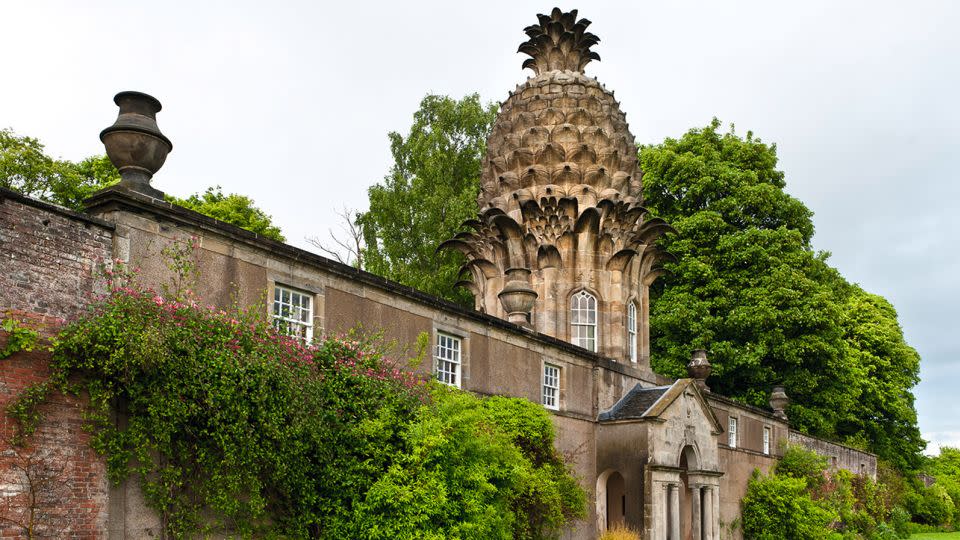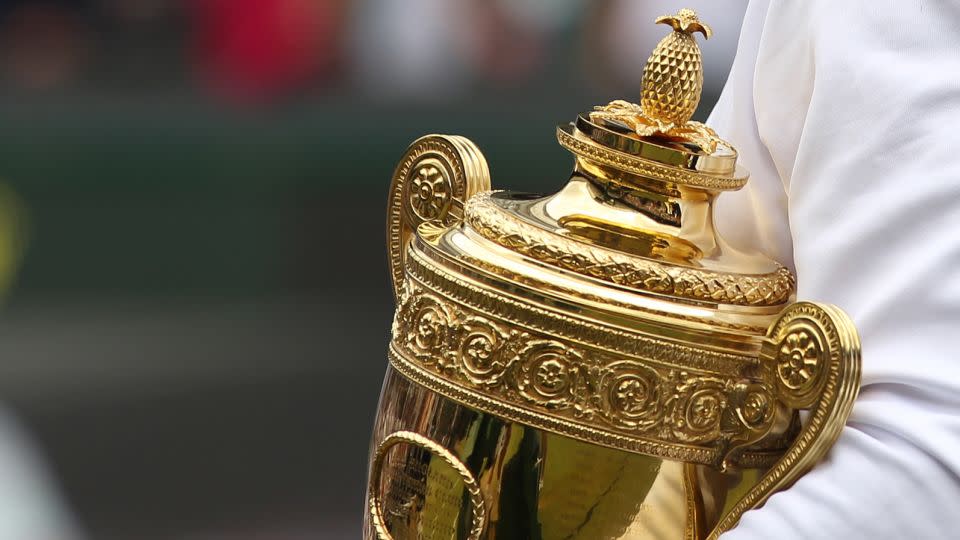‘Like eating a Gucci handbag’: How an exotic fruit once became the pinnacle of luxury
- Oops!Something went wrong.Please try again later.
In a painting from 1675, England’s King Charles II stands on a terrace as the royal gardener kneels before him offering up a curious present.
It’s one of the most desirable items of the era, representing the ultimate in luxury and prestige. Imported from a faraway land, it’s among the first of its kind to have made the journey from the New World to Britain.
It’s a pineapple.
Today, the exotic fruit would hardly qualify as a suitable gift for royalty. But in those years, pineapples were at the beginning of an arc in history during which they would become — particularly in Britain — a symbol of wealth and opulence unlike any other. Pineapples still adorn the top of the western towers of St. Paul’s Cathedral, one of London’s most iconic landmarks.
The painting, which was commissioned by the king himself and is attributed to his court painter, Dutch artist Hendrick Danckerts, was once believed to commemorate the first pineapple grown in England. However, that didn’t happen until later.
“The pineapple that was given to Charles II had been shipped over from Barbados,” said Francesca Beauman, author of the book “The Pineapple: King of Fruits,” in a phone interview.
The king’s diarist, John Evelyn, had recorded the moment Charles II first tasted the fruit at a banquet held for the French ambassador in 1668. In that setting, the very sight of the scaly produce would have been met with gasps of wonder.

“Pineapples were very sought after from the very beginning, because the explorers who had come across them in the New World wrote about them in rapturous terms, raving about how delicious they were,” Beauman said.
Its popularity extended to British North America, where a young George Washington was among the admirers of the fruit. “None pleases my taste as do’s the Pine,” he wrote in his diary during a trip to Barbados in 1751.
Because pineapples are not mentioned in the Bible or in any old texts from Greece and Rome, she added, they had no existing resonance. The English could therefore impose upon them whatever resonance they wanted, and the pineapple became the king of fruits — taking root in British culture in more ways than one.
Homegrown delicacy
Pineapples need very high temperatures to grow, and they take years to mature. Nevertheless, once they became established as the most desirable of fruits, people started cultivating them in Britain.
“Despite the fact that obviously it’s a fool’s project, as England and Scotland have a cold and rainy climate, by the 1770s anyone who was anyone amongst the upper echelons of society was growing their own pineapples — it became an essential feature of a country house garden,” Beauman said.
This came at a great expense and difficulty. It required the construction of special greenhouses called “pineries,” which needed to provide heating to the plants from below, using stoves that constituted a fire risk. “It was rare and special that you actually succeeded,” Beauman said. “To even grow one pineapple was a huge achievement that people would show off all the time.”
The construction and heating costs, as well as the time required to obtain the fruits, made a single pineapple cost up to 80 pounds, according to Beauman’s calculations — that’s almost a whopping $15,000 in today’s money.
“That was about the same cost as a new stagecoach with horses — the equivalent of buying a new car in Georgian England,” she said. “People had a full-time garden boy who would sleep among the plants to make sure that they didn’t burst into flames by mistake. It was a way of showing off your wealth, and it quickly became a status symbol.”
Pineapples for rent
While the fruit became enshrined in British culture as an aesthetically pleasing beacon of distinction, it was seldom eaten.
“If you were very rich and had a really amazing gardener, the first thing you’d want to do was send a fancy friend a pineapple as a present,” Beauman said. “It would also be displayed on the dining room table as a status symbol, and commonly it would sit there until it began to rot, because why on Earth would you eat a pineapple? It’d be like eating a Gucci handbag.”
So prized was a chance to be seen with the fruit that, according to Beauman, there were instances of pineapple rentals, where a fruit would be loaned for a few hours to be carried around at a party, then returned.
Eventually, the pineapple started being incorporated in all kinds of designs, including architecture and crockery.
“I would argue that the pineapple is naturally decorative,” Beauman said. “It’s easy to stylize and recognize, it’s sort of symmetrical, it’s quite simple. But it also allowed the aristocracy to communicate their values in a very straightforward way. And that’s why the most popular form of representation was a stone pineapple on a gate post. That was common as a symbol of Georgian gentility around the 1770s and 1780s, a way to mark out the limit of a property in a very public way.”
Many of these pineapples survive on gate posts across Britain to this day, as well in some notable buildings associated with royalty, such as the Dunmore Park estate near Stirling, Scotland, a former residence of the Earls of Dunmore, built in 1761. It features a 53-foot-tall pineapple towering over its surroundings. Another notable example is the pineapple that adorns the top of the Wimbledon trophy assigned to the winner of the Men’s Singles tournament.

When the exotic delicacy started being imported in large quantities, from around 1820, its status as the ultimate luxury became tarnished.
“By 1850, 200,000 pineapples a year were being unloaded on London’s dockside,” Beauman said. “Then, when refrigeration and canning came, later in the century, they really became ubiquitous.”
However, that still wasn’t enough to make their desirability collapse, as confirmed by a passage in Charles Dickens’ “David Copperfield,” which was written in 1850. In the book, David says that when he had money, he’d get coffee and bread, but when he had none, he strolled as far as Covent Garden and “stared at the pineapples.”
“For a boy like David Copperfield, in 1850,” Beauman said, “a pineapple would still be a glimpse into a world of unimaginable opulence.”
For more CNN news and newsletters create an account at CNN.com

